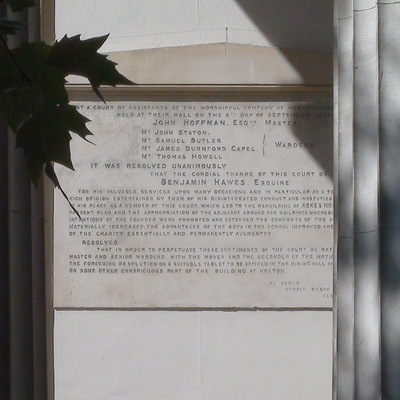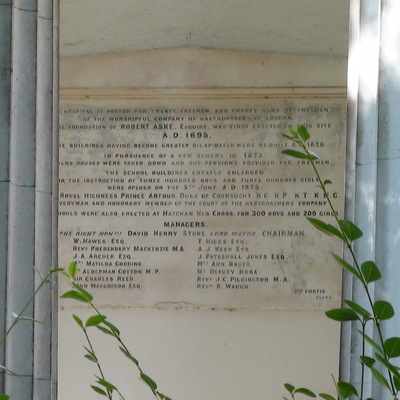About the building, from Shoreditch College: "The first building on {this site} was Aske's Hospital or the Haberdashers' Alms Houses, erected 1690-93 to designs of Robert Hooke ... for the Worshipful Company of Haberdashers, who were left a legacy of £30,000 by a member, Robert Aske, to provide a building for the accommodation of twenty "decayed members" of the Company. .... {drawing held by the V&A} according to James Elmes (Metropolitan Improvements 1828), it was very spacious, being four hundred feet long, with an ambulatory in front stretching some three hundred and forty feet under a colonnade. ... Hooke's building was pulled down and rebuilt by the Haberdashers' Company between 1825 and 1826. The new building, much smaller than the original, is a good example of the Greek taste in Regency architecture. It is distinguished by its fine central Doric portico flanked by plain stock brick wings. The architect, D.R. Roper (c.1773-1855), had made a name for himself as a surveyor in his valuations of property in connection with the formation of Regent Street. Elmes ... was critical of Roper's portico "with its frieze emasculated of its many triglyphs, and a substitution of hybrid wreaths," but he generally approved of "the present neat structure"."
The hospital (almshouses and school) was built to house twenty freemen and twenty sons of freemen of the Worshipful Company of Haberdashers. Rebuilt 1826. In 1873-5 the almshouses were redeveloped to provide more space for the school. 1898 the school moved away: girls to Acton and boys to Cricklewood.
In 1907 Shoreditch College moved in and became Shoreditch Technical Institute and then Shoreditch Training College. It moved to Coopers Hill in 1951. An off-shoot of the Institute, the London College of Furniture, started here in 1964 and then moved to Commercial Road as part of London Guildhall University.
Note the statue on the lawn shown in the 1828 image. This is probably the one moved to Hatcham in 1908. We've found two other almshouse statues that have moved - see Dick Whittington.









Comments are provided by Facebook, please ensure you are signed in here to see them